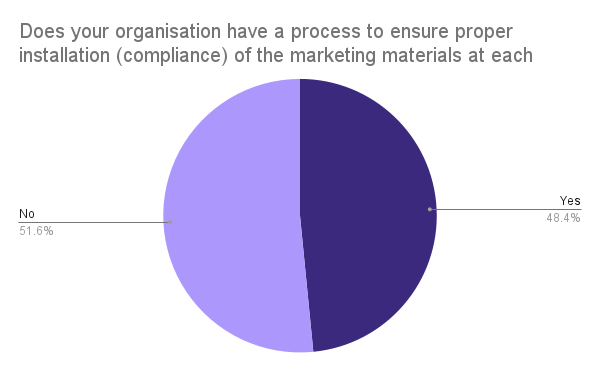5 Steps to Ensure In-store Promotional Compliance


The store floor is the critical point where campaigns meet consumers. After days, weeks, and months of planning and creating a campaign, it can all be for nothing if the execution isn’t right in every location. We surveyed marketing leaders at 225 multi-location retailers to identify the top methods they use to ensure promotional compliance.
In general, half of retailers have a clearly documented process to ensure the proper installation of marketing materials in every location. For those with a process, there were five common themes mentioned by retailers: Centralised Communication and Oversight (18%), Content Management & Guidelines (21%), Store Personnel and Dedicated Staff (34%), Technology & Tools (11%), Verification and Monitoring (16%).
With promotional compliance ultimately determining whether your campaign is a success or a failure, why is there no standardised method? In this article, we uncover the results of our independent research to identify the best method of managing compliance.
The information in this article discusses findings from our recent whitepaper, which interviewed senior marketers at 225 multi-location retailers in North America. You can download the full version here.
The retailers we surveyed are astute planners. 83% say they provide a “guide” to store management so they know exactly where and how to place all materials. Whether distributed by email, planogram or as a physical print-out alongside their marketing kits, these plans are an essential first step in ensuring marketing campaigns are executed accurately in-store.
However, it isn’t the entire picture. The table below shows that less than half of retailers have a process to ensure compliance.

Less than half of retailers said they have a process to ensure the proper installation of marketing materials at each location
| Does your organization have a process to ensure proper installation (compliance) of the marketing materials at each location? | Total | Percentage |
|---|---|---|
| Yes | 109 | 48.4% |
| No | 116 | 51.6% |
Interestingly, even 54% of marketers that said they have a process still described poor compliance as an issue. When we asked respondents to describe their process, it became clear that every retailer was different.
When we asked retailers to explain their process, there were five common themes mentioned, shown in the table and chart below.

5 Methods Retailers Use to Ensure Compliance in every location
We asked retailers that said they had a process for ensuring compliance to explain it. Using AI, we categorised their responses into 5 common themes.
| Please describe the method you use to ensure proper implementation of marketing materials in every location | Count | Percentage of Total |
|---|---|---|
| Centralized Communication and Oversight | 15 | 13.76% |
| Content Management and Guidelines | 17 | 15.60% |
| Store Personnel and Dedicated Staff | 28 | 25.69% |
| Technology and Tools | 9 | 8.26% |
| Verification and Monitoring | 13 | 11.93% |
| Other / No answer | 27 | 24.77% |
| Total | 109 | 100.00% |
Let’s dive into each of these ideas to explore what this looks like in practice.
This top-down approach maintained control with corporate headquarters. Typically, it used corporate or regional representatives to call, email, or visit each location regularly or after each installation.
This approach commonly involved sending physical or digital guides of planograms to stores. Plans would include the times when materials should be set up. And store managers would sign off on the sheet when complete and return it to corporate headquarters. Additionally, some retailers provided instructions in video format so their teams could watch and learn how to implement materials.
In combination with the other methods, most retailers delegated responsibility for campaign setup to store managers. In some cases, store managers provided photographic evidence to demonstrate compliance.
The technology and tools used to support compliance ranged from workforce management and campaign management platforms that managed the entire communications process to CMS platforms and intranets to share information. While only a few retailers reported using this method, it was very effective.
Verification and monitoring were commonly used alongside other practices above. Mostly, verification was reported through photo submissions or signed checklists. However, some retailers hired secret shoppers to provide feedback on compliance, while others used a top-down approach, with regional managers inspecting materials.
If you don’t have a process at the moment, this article should already have given you ideas to get started. However, if you have a process and compliance is still causing you headaches, then the most important step to add is Verification & Monitoring.
While 54% of retailers with a process still described ensuring compliance as being a significant issue, none of the 13 retailers using verification and monitoring methods as part of their processes described promotional compliance as a pain point.
Of course, implementing verification and monitoring isn’t a simple process. If only 13 out of 225 retailers are using this method, the big question has to be, why aren’t more using it? And, importantly, how can multi-location retailers implement it?
We talk about how to ensure 100% compliance in more detail in this article. However, for this article, we wanted to dig into what our survey respondents thought.
Retailers are beginning to realise they can no longer continue with the same processes. We asked retailers for their thoughts on using technology in some specific situations to support their in-store marketing, and they were overwhelmingly in favour. The chart below shows that 86% of retailers said that having online audit/compliance capabilities for every location in their organisation would be helpful. Only 3% said it wouldn’t be helpful.

97% of retailers would find technology helpful, but only 14% are using anything more than spreadsheets and email.
Indeed, when we asked retailers what technology they used to manage their marketing materials, 86% of retailers said they use a combination of email, spreadsheets and Google Docs. You can read the full breakdown of this data in this article.
At Colateral, we’re on a mission to eradicate inefficiencies and accelerate physical marketing performance. We support global retailers and brands with more than 10,000 locations to achieve 100% compliance. Our platform enables marketers to streamline operations from campaign planning to execution and analysis. We help integrate marketing and store teams to dynamically maintain store information and audit their campaigns to provide real-time feedback and mitigate errors.
If you would like to improve your in-store marketing compliance, request a free consultation to see how we can help.
This article takes inspiration from our latest whitepaper, which interviewed marketing leaders in 225 multi-location retailers to understand their challenges and processes. As well as compliance, they discuss campaign localisation, the comms chasm in retail and artwork management processes.
 Thought Leadership
Thought Leadership
Retail audits are used to collect valuable information about your store estate and the effectiveness...
 Thought Leadership
Thought Leadership
Nothing captures someone's attention more than a message tailored specifically to them. And shoppers now...